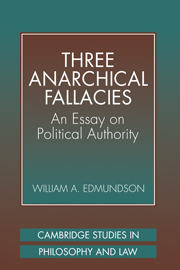Conclusion: The State for What?
Published online by Cambridge University Press: 19 March 2010
Summary
“The two parties which divide the state [are those] of Memory and [of] Hope.”
Emerson, “The Conservative”My argument against the three fallacies is now done. In some ways, I hope, the later parts have reinforced those they follow. The conclusion of Part One was that legitimacy entails a prima facie duty not to interfere with the state's administrative prerogatives. The possibility that such a duty in fact exists, and that there are in fact legitimate states, should be reinforced by the conclusion of Part Two, that law is not essentially coercive. If law were essentially coercive it would be that much harder to believe there is a prima facie duty not to resist it. Similarly, if Part Three was successful, it showed that the state may enforce whatever morality may; and this conclusion should make the conclusion of Part Two more credible – that law is least coercive where its requirements track those of morality.
Once the three fallacies I set out to expose are out of the way, what then? Exposing the first fallacy tells us only that a legitimate state is one whose administrative prerogatives impose on us a prima facie duty of noninterference. I have given some reasons to think that there is such a duty, but to prove that there is would require further moral argument.
- Type
- Chapter
- Information
- Three Anarchical FallaciesAn Essay on Political Authority, pp. 179 - 186Publisher: Cambridge University PressPrint publication year: 1998

